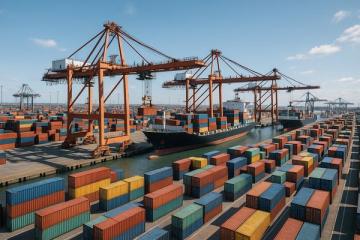
As the global supply chain prepared to recover from the collateral damage caused by COVID in 2022, China lockdowns hit the industry back at a time when the companies prepared to kick off the produce shipping season (April-July). Disruptions, one after the other, are taking the capacity away from the market.
As a result of the Zero COVID strategy in China, many factories reopen while others further go into shut down.
Historically, this time of the year is crucial for most companies as they begin to ship fresh production in preparation of the early peak season. Lockdowns in China will not just be a production slowdown, but also a slowdown of cargo movement, both being detrimental to the supply chain. While the ports in the United States will not feel the pinch before 3-5 weeks until the backlog improves.
In the past one month, from February to March, average container prices have declined from 12-18% at ports of Shenzhen, Qingdao and Ningbo amongst others. Going by how the average prices developed last year after the Ningbo port shut down (July –August 2021), we expect the prices to increase in the long run. Zooming in, these average prices are expected to decline for a few days or weeks as these ports in China experience restricted exports, while still importing. Once the Chinese ports fully resume operations, there will be pressure to deliver more containers which will lead to rise in average container prices in the next few months as the industry inches closer to the pre-peak season. What remains to be seen is whether the prices reach the old highs.
12-18% decline in average container prices in China
So far, the impact on average container prices is limited. As the Shenzhen city officials announce resuming of transportation and factories from COVID induced lockdowns, industry analysts are positive about the minimum impact this this hiccup would have on the overall supply chain.
The platform data of Container xChange shows that the average prices of 40 ft high cube cargo worthy containers at the port of Shenzhen dropped by 12.4% from $5887 on 27 February to $5154 on 20 March 2022. For a 20 ft cargo worthy DC at Shenzhen, these prices fell by 18.8% from $2800 on 15 February to $2272 on 20 March.
At the port of Ningbo, the average prices for 40 ft cargo worthy HC containers dropped by 15.8% from $5930 on 14 February to $4990 on 20 March 2022 and for 20 ft cargo worthy DC the prices dropped by 13.5% from $2603 on 14 February to $2251 on 20 March 2022.
At the port of Qingdao, the average prices for 40 ft cargo worthy HC containers dropped by 12% from $5420 on 26 February to $4748 on 20 March 2022 and for 20 ft cargo worthy DC the prices dropped by 12.5% from $2360 on 26 February to $2064 on 20 March 2022.


China–US Traffic to complicate further if lockdowns were to persist
“If persisted, the lockdowns will delay container movement significantly at these ports which will have the maximum impact on the US shipments. Looking in the long term, this will add create more chaos as rates climb higher, capacity tightens and shipments delay. The shippers will need to plan their cargo much more in advance in 2022 than the last year, given the geopolitical scenario, the upcoming US West coast contract negotiations in July and the rail route disruptions.” said Dr. Johannes Schlingmeier, cofounder and CEO, Container xChange
Another interesting point of consideration could be contract negotiation between the longshoremen’s union and the West Coast shipping ports which is set to expire on July 1, 2022. Going by the analogy that the containers from China (hopefully) will make their way to the US ports around the same time in July-August (delayed by the China lockdowns), they will be bound to face worsened congestion at the US west coast ports as well as at the East coast ports which are already struggling to handle the traffic.
If industry reports are to be believed, the last negotiation in 2014-15 had led to four to five months of slowdown at the west coast ports.
“In the coming months, the transpacific route will witness a major disruption, and shippers must think ahead and prepare for the worst as port congestion worsens, freight rates shoot up and capacity deteriorate.”





